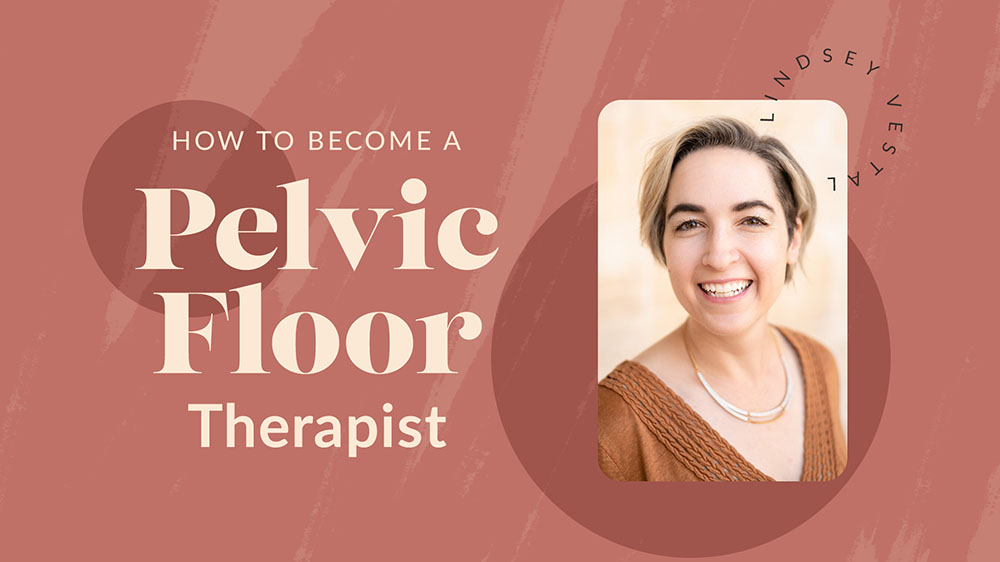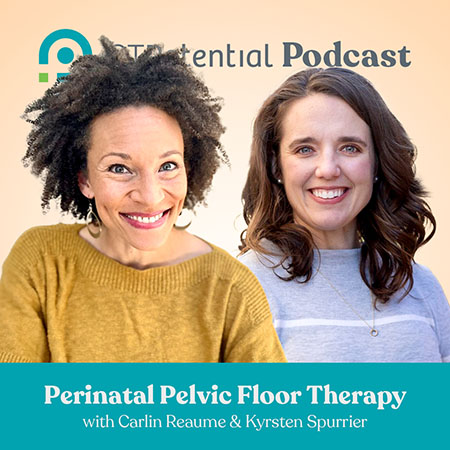
Pelvic floor therapy has been shown as both clinically and cost-effective.
And, considering the holistic nature of occupational therapy, ideally we are equipped to provide pelvic floor therapy and pelvic health supports.
But, we need more occupational therapy (and physical therapy!) professionals to pursue careers in pelvic health. In this post, we’ll provide a simple checklist for those interested in the pelvic floor therapy specialty. Then, we’ll run through a Q&A with Lindsey Vestal, a pioneer in pelvic health OT, where she discusses her own professional journey and shares her advice on navigating all the different stages.
Basic steps to becoming a pelvic floor therapist
Here are the basic steps to becoming a pelvic floor therapist:
- Get licensed as an occupational therapy or physical therapy professional.
- Gain competency in pelvic floor therapy.
- Earn related certifications (optional).
Possible certifications include:
- Pelvic Rehabilitation Practitioner Certification (PRPC)
- Certification in Pelvic Muscle Dysfunction Biofeedback
- Trauma Informed Pelvic Health Certification
While these steps look relatively simple, each part of the journey involves much more than meets the eye.
To help us unpack all the details, we are excited to share our interview with Lindsey below!

What it takes to become a pelvic health OT: an interview with Lindsey Vestal
What initially sparked your interest in pelvic health?
Lindsey: I discovered this amazing specialty by watching my very gregarious and outspoken father develop urinary incontinence (an inability to control leaking) when he was diagnosed with prostate cancer.
He became a withdrawn, less socially active member of his community as result of his incontinence.
Watching this transformation, I did as much research as I could, and I remember learning that the pelvic floor is a set of muscles. We go through rehab for our shoulders and knees when they work less optimally than we’d like, so I wondered, “Why couldn’t we do the same for our pelvic floor muscles?”
Once I discovered that there was a profession that provided this type of care (and that it has been around since the 1990s), I found my father someone to work with—and at the same time, I found my life’s work.
What made you pursue OT versus PT to become a pelvic floor therapist?
Lindsey: Well, it’s an interesting story. I always thought I would become a PT in order to pursue pelvic floor therapy studies. Before applying to grad school, when I was getting my shadowing hours under my belt, the PT I was following called in sick one day.
The rehab director placed me with an OT, and I had no idea what occupational therapy even was! In the session I observed, the OT was focusing on building long-term and short-term memory skills.
I was so intrigued by this form of rehab—where we could address the mind as well as the body.
From that day forward, I did not look back! For my graduate school foundation, I chose OT specifically because I was drawn to the holistic framework. I thought the OT perspective would provide a great foundation before I pursued the pelvic health continuing ed studies that both PTs and OTs must complete.
What was it like pursuing pelvic health OT before it became a widely recognized speciality?
Lindsey: I graduated from NYU in 2011, and I’m totally one of those geeks who always knew she wanted to serve women (and men) by bridging the gap between the body and the mind. I applied to graduate school already knowing I planned to pursue pelvic floor therapy.
I knew that graduate school itself was not going to provide much exposure to the pelvic health specialty—that I was going to have to pursue it through continuing education after graduation.
Did you consider working for an established clinic—or did you work for one—before starting your business?
Lindsey: Yes, I did work for an established clinic before starting the Functional Pelvis.
I find mentorship such a valuable part of building skill sets.
This is true with most professions, but most certainly with pelvic health. Each person is so unique, and following a protocol is not the best way to serve our clients.
By working with someone who has experience, you start to develop the individual clinical reasoning skills necessary to tailor your sessions to each client.
You build confidence and start to really evaluate each client uniquely.
However, I have to share something with you: Getting a job within pelvic health with an OT degree was not an easy task, and meeting a mentor was certainly a challenge.
This is one of the biggest reasons I started my own online training course for OTs. I think OTs are uniquely suited for this incredibly rewarding field.
What made you decide to venture out on your own?
Lindsey: I wanted to be able to offer my clients more of a specialized experience than I could give them in a typical outpatient setting.
First, I wanted more time with them during each session—at the Functional Pelvis, evaluations are 90 minutes and treatments are 60 minutes.
In order to provide the type of experience that most pelvic floor clients need—which includes hands-on work, relationship-building, and tons of education—I required this amount of time with them.
I also wanted the ability to treat them in their homes—where the most functional training occurs.
In most of my sessions with new moms, we review transferring their babies into cribs, practice optimal posture while standing at changing tables, and analyze how they are holding the car seat as they climb stairs.
I wanted to provide them with the tools they needed to see improvement in their bodies, while also helping them understand why these interventions are effective.
I wanted my clients to become detectives for their own bodies, and feel empowered in the process.
For me, this meant creating my own business.
Was there a moment when you realized it was time to start on your own business?
Lindsey: It was when I thought of the home being an ideal place to treat this population, and I found that no one else was doing it here in Manhattan.
That’s when the idea of the Functional Pelvis was born.
How did you find your earliest clients?
Lindsey: My first year, I visited doctors, dropped off flyers, and sometimes had the opportunity to chat with them about my work.
I did not see much growth this first year.
My second year, I started offering community workshops—and that wound up being a phenomenal growth year.
Being able to be in front of my potential clients—enabling them to get firsthand experience with my approach and my personality—really fueled referrals for me.
I also joined networking groups and built relationships with other referral sources such as doulas, childbirth educators, and fitness professionals.
I even started a pelvic floor “study group” for any professionals interested in the pelvic floor; we still meet monthly.
My third year in business, I started to see more referrals come in from doctors, because they started hearing about me from their clients. It came full circle.
What is your biggest referral source?
Lindsey: I am 100% word-of-mouth. I do no marketing at this point.
What are some of the biggest challenges and rewards of your role?
Lindsey: I would say my biggest reward is also my biggest challenge: debunking myths around what the pelvic floor actually is. (Most people still think kegels are the one-stop shop for any pelvic floor dysfunction.)
My primary mission is making sure people get accurate, positive pelvic floor health information.
Pelvic health therapy is often provided by PTs, so when I take my continuing ed coursework, I am usually the only OT present.
I have begun to connect with lots of OTs in both the US and Canada who are working in this field. I really feel like it’s a natural fit for OTs since our scope of practice encompasses both toileting and sexuality.
Additionally, our background in mental health really prepares us for some of the more significant challenges that this population faces.
What are some of the ways that pelvic OT differs from pelvic PT? How do you differentiate the two to potential clients?
Lindsey: OTs, by nature, are holistic thinkers.
We excel at task analysis (which is crucial in pelvic floor therapy). OTs also address psychosocial aspects of therapy (a MUST in pelvic floor therapy).
While the pelvic floor muscles are just like any other group of muscles in the body, it takes a certain sensitivity and an ADL background to really evoke change.
If I were to just assign three sets of 10 of bridges or clam shells to someone who has weak glutes in order to address their concerns of urinary leaking, I would be missing the whole person.
Alongside exercises, we examine the behavior that is contributing to their symptoms, and we address the vulnerability that their symptoms are causing.
We look at posture, stress triggers, sleep hygiene, and food and beverage habits. We look at them as whole entities, assessing all of the contributing factors.
Of course, I have met PTs who practice this way, but it is not consistent across the profession.
In contrast, OTs by nature (and by training) always practice this way. Our considerate, deliberate, and kind approach—and our ability to take into account the entire being—makes such a difference.
Do you have any challenges associated with working in people’s homes, or is it usually a good thing?
Lindsey: There really is nothing like working in someone’s home.
It’s literally meeting a client where they are—physically, emotionally, and psychologically.
If someone wants to become a pelvic health OT, what are the most essential steps they should take to get there?
Lindsey: The answer to this question depends largely on where they are in their career.
If I was just starting out, and I wasn’t sure whether the pelvic floor specialty was for me, I would take my course, OT Pioneers: Introduction to Pelvic Floor Therapy (a shameless plug!). It’s online, so there is no travel required—and no hotel costs to rack up.

If I was in my first few years of specializing in pelvic floor therapy, I would take the mentorship track of the same course. This enables people to get more direct feedback from me in a small group setting.
If I had $1,000, and I was just starting out, I would take Pelvic Floor Level 1 through Herman and Wallace. This course gives folks their first hands-on experience with internal exams. (Herman and Wallace has been really gracious in their support of my work. They even gave me a 10% discount to pass along to fellow OTs. Just use the promo code: OTR10.)
There are so many other courses that I love, including Biofeedback Training and Incontinence Solutions with the OT/PT team Jane Kauffman and Tiffany Lee.
What courses do you recommend?
Lindsey: There is no prescribed, linear path to pursuing pelvic floor therapy, so this is actually a very challenging question to answer.
Some of the courses that I think really complement pelvic floor therapy include those focused on myofascial release (like the courses provided by John F. Barnes), Maya Abdominal Massage, visceral manipulation, and craniosacral studies.
From a fitness and exercise studies perspective, I love Restore Your Core with Lauren Ohayon (she has a teacher training track), as well as education offered by Jenny Burrell and Julie Wiebe.
What are some of the best moves you’ve made on your journey?
Lindsey: Building relationships within my community.
People get to know you, see your passion, and then work with you. Then they make referrals, which beget referrals, which beget more referrals.
Starting a pelvic floor “study group” (comprising pelvic floor therapists, doulas, childbirth educators, midwives, fitness professionals, etc.) and participating in fundraisers for local perinatal organizations have both been very helpful in helping my business grow.
What is your favorite part of being in pelvic health?
Lindsey: People often become very withdrawn from participating in their ADLs and IADLs when incontinence or pelvic pain becomes a struggle for them.
It is so rewarding to empower them to take control over the very basic function of bowel and bladder management.
Where do you hope to see OT and pelvic health in 10 years?
Lindsey: I hope to see more and more OTPs stepping into leadership roles within pelvic health. There is nothing more “ADL” than peeing, pooping, and intimacy!
Our biopychosocial lens truly prepares us to step into this specialty with such integrity. It is one of the most fulfilling specialties I have worked in. Each client is like a puzzle, making the work so intellectually and emotionally fulfilling—with little to no burnout.
I also hope to see more people referring to pelvic health specialists as pelvic rehab professionals instead of being so discipline-specific. We aren’t specific when we refer to lymphedema therapy or even hand therapy, so I’d like to see that change happen in pelvic health as well. This will result in more people getting the care they deserve.
You mentioned your online course. Where can we find out more about it?
Lindsey: For anyone interested in learning more about my online course, please visit:
OT Pioneers: Introduction to Pelvic Floor for Occupational Therapists
Conclusion
We need more OTs stepping into the incredibly fulfilling and beneficial niche of pelvic health, so keep it in mind as you grow your career! Not only does our holistic approach align perfectly with pelvic health, but also there simply aren’t enough OTs practicing in this area.
If you’re interested in pursuing this path, a great first step is to build your awareness with free sources of information. You can join Lindsey’s Facebook group, OTs for Pelvic Health, and follow the Functional Pelvis on Instagram to get a better idea of whether pelvic health is right for you. Then, if you decide you want further training as a pelvic floor OT, check out Lindsey’s course!
Finally, you can hear more from Lindsey (and about the research behind pelvic health OT) by listening to OT Potential’s podcast episode/CE course: OT and Pelvic Health.




5 replies on “Become a Pelvic Floor Therapist (for OT & PT)”
Excellent information! I have been a COTA/L for 25 years. I am currently enrolled in a bridge program to become an OTR/L. I was unaware of this area of OT until a classmate told me she was working in a pelvic health clinic owned by an occupational therapist. This may be the area I pursue. Thank you for the information!
Oh awesome! I’m so glad you found this post, and i DO hope you pursus this! Good luck in your program, and I can’t wait to for you to be an OTR/L!
COTA/L also can work with pelvic floor therapy also correct ?
I would love to explore this area.
I have been looking for this for over a year. I was a lay midwife in my younger years, then became an OTR. I labored with my daughter in a PA hospital, and the Dr. observed I knew what I was doing. They were short-staffed, so pretty much besides an occasional check left us alone until she was ready to deliver. I caught my grandson, and the Dr. said she wished I could work with her all the time. I need steps. Am very interested in doing pelvic floor therapy.